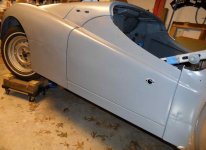TexasKnucklehead
Jedi Knight
Offline
I'm as ready as I can be. Aside from time and warmer temperatures, all I lack is experience and know-how. My neighbor has been a great adviser, but we can't seem to get a day to actually put on some bondo. Where do I start?
My tub and all the panels have been primed with epoxy primer and "bumped" as well as I can expect. I have a gallon of Rage Gold, some hardener, red scotch brites, sanding blocks and paper, paint thinner, lacquer thinner, grease and wax remover, high-build primer, hardener, mixing cups, HLVP gun with 1.8mm tip...
I've been reading on the web and see a number of different preferences. A consensus is not possible, but since I had the tub epoxy primed about 6 months ago, I plan to 'rough the surface' with the scotch brites before applying filler. When do I wipe down with wax remover or thinner? Before sanding, or after? I'd like an outline of the steps to take and any insight that might help with my first attempt at body work. The directions on the Evercoat can specify drying time from 75 to 80 degrees, what if I'm outside that temperature range? I'd really not like any of the filler to fall off while I'm on my first test drive.
Suggestions welcome.

My tub and all the panels have been primed with epoxy primer and "bumped" as well as I can expect. I have a gallon of Rage Gold, some hardener, red scotch brites, sanding blocks and paper, paint thinner, lacquer thinner, grease and wax remover, high-build primer, hardener, mixing cups, HLVP gun with 1.8mm tip...
I've been reading on the web and see a number of different preferences. A consensus is not possible, but since I had the tub epoxy primed about 6 months ago, I plan to 'rough the surface' with the scotch brites before applying filler. When do I wipe down with wax remover or thinner? Before sanding, or after? I'd like an outline of the steps to take and any insight that might help with my first attempt at body work. The directions on the Evercoat can specify drying time from 75 to 80 degrees, what if I'm outside that temperature range? I'd really not like any of the filler to fall off while I'm on my first test drive.
Suggestions welcome.


 Hi Guest!
Hi Guest!

 smilie in place of the real @
smilie in place of the real @
 Pretty Please - add it to our Events forum(s) and add to the calendar! >>
Pretty Please - add it to our Events forum(s) and add to the calendar! >> 






